The records of the United States Sanitary Commission, recently reprocessed by The New York Public Library, are a vast and newly accessible resource for Civil War era family history research. The collection contains a wealth of materials useful for genealogical research.
However, the size and complexity of the archive requires researchers to spend time learning about how the collection is organized for the best research results. This article provides an introduction to this multifaceted collection.
Introduction
In 2013 following a major three-year processing project, The New York Public Library’s Manuscripts and Archives Division reopened the records of the United States Sanitary Commission (USSC), an important Civil War humanitarian organization run by civilians and authorized by the United States Government. The NYPL’s collection guides (finding aids) are searchable online at archives.nypl.org, the NYPL’s search portal for its archival holdings.
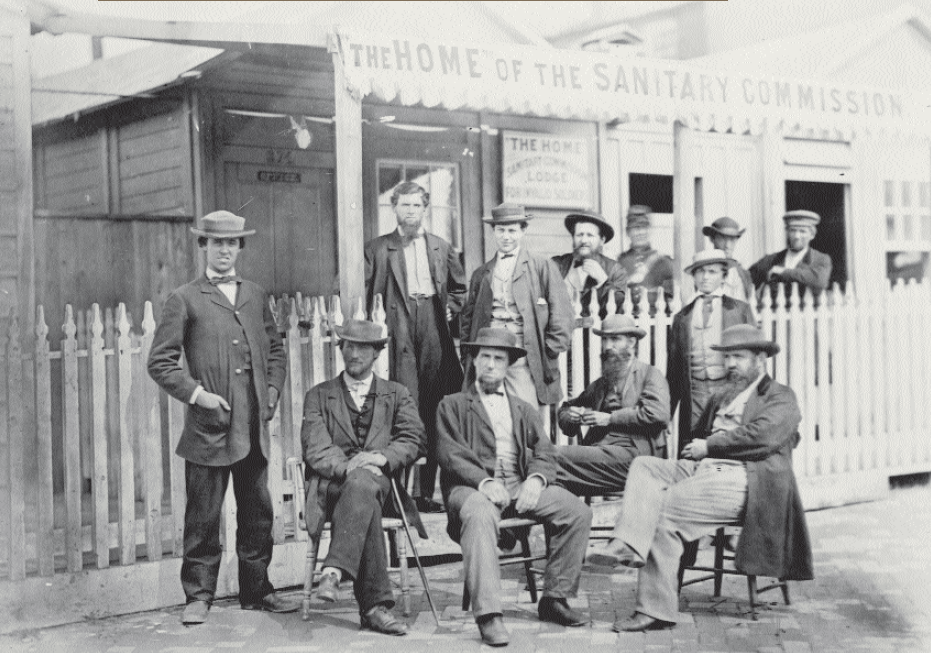
Commission Lodge for Invalid Soldiers" in
Washington D.C.
c. 1861 - 1865 (via Library of Congress)
The fundamental mission of the USSC was to monitor the condition of the health and well-being of the armed forces, and to advise the government, particularly the Army Medical Bureau, on ways to address any deficiencies and anticipate any needs to help win the war. It also distributed supplementary supplies to camps, hospitals, and armies in the field. These supplies, as well as cash, were donated by the American people through the USSC’s branch organizations, working with individuals and local aid societies. Over the course of the war, the USSC developed “special relief” services to address the needs of servicemen and their families falling outside the scope of military responsibilities. Notably, it created a claim agency system to help servicemen and their families file pension and other claims with the government, free of charge.
The collection — an incomparable record of how Americans participated in, and experienced, the Civil War — contains materials created by the USSC from 1861 to 1879, and was donated by them to the Astor Library in New York City, one of the predecessor institutions of The New York Public Library (NYPL). From 2010 to 2013, thanks to a generous grant from the Robert W. Wilson Charitable Trust, the enormous collection was arranged, described, and rehoused. To learn more about that work, read the NYPL’s United States Sanitary Commission Processing Project blog posts on the NYPL website.
Getting to Know the Collection
The collection, the United States Sanitary Commission Records, 1861–1879 (MssCol 3101), is comprised of 20 record groups totaling nearly 1,000 linear feet of materials. These include the records of its executive offices, departments, auxiliary branches, and its post-war entities; its financial records; and its own compilations of published and graphic materials. Each record group has its own call number (MssCol #) and a detailed collection guide.
Collection guides describe the organization and its activities, and tell what records exist, how they are arranged, and what information is found in them. The best place to start is the helpful master guide to the entire collection (MssCol 3101), providing a brief history of the Sanitary Commission, an overview of the collection as a whole, and a brief description of each record group, with a link to its guide http:/archives.nypl.org/mss/3101 . The USSC was a large and complex bureaucracy, and its record keeping practices are essentially those of a large nineteenth-century corporation. Reading a collection guide in its entirety will ensure that all potentially useful materials are identified.
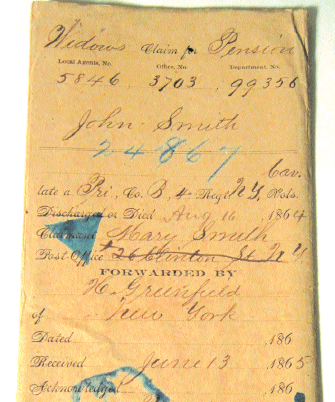
for Mary Smith, wife of Pvt. John Smith, Co. B,
4th N.Y. Cavalry. Additional records tell the
complete story of her claim application.
When reading the online collection guide of a particular record group, researchers can easily navigate to the others by clicking on the “USSC records finding aid” link under “Additional Resources” on the “Overview” tab. Digital images — primarily photographs and other graphics — from the USSC records are available in the NYPL’s Digital Collections website, and many will eventually be linked directly to the collection guides.
Family History Potential
The records document the USSC’s interaction with thousands of servicemen and civilians, and the work of its staff and supporting volunteers.
For family historians, the records of primary interest are those of individual military serviceman (soldiers and sailors) whose records are easiest to access by surname. These include the records of the USSC’s claim agencies, collected in the Army and Navy Claim Agency Archives (MssCol 18809), and its Hospital Directory (Hospital Directory Archives, MssCol 19877). Some researchers may wish to explore how families supported the war effort on the home front. The collection also documents home front activities, particularly the work done by many USSC branches and aid societies supporting supply and relief operations. Both types of records are described in more detail below. The lives and contribution of New Yorkers are visible throughout.
Although the USSC originated in New York, due to the nature of its work, its records encompass servicemen from many states, including men whose families may have migrated westward from New York. New York units served in many military theatres of war. While most records concern soldiers, naval personnel are also represented in the collection. Additional documentation of USSC activities regarding individual servicemen or military units are mentioned in this article with reference to their collection guides for further exploration. In many of these other record groups, individuals are rarely indexed by name.
Claim Records
Records created by the USSC claims agencies are by far the most important genealogical resource and comprise nearly one-third of the collection’s physical bulk. The USSC established its Army and Navy Claim Agency (MssCol 18809) in Washington D.C. on April 1, 1864 to serve as the USSC’s central claim office. The office assisted Union soldiers, sailors, and their families in prosecuting claims on the federal government for pensions, back pay, bounty, commutation of rations, seamen’s prize money, and other benefits. These claim services were provided without cost to the individual, one of many USSC special relief services offered to servicemen and their families.
The records of this work date from 1861 to 1870 and include the records of predecessor agencies, as presented in the collection guide for the Army and Navy Claim Agency Archives. The guide describes:
- the records of the central office in Washington (the Army and Navy Claim Agency, hereafter ANCA) and its related Pension Agency
- the records of ANCA’s network of affiliated (local) claim agents across the United States
- the records of two of its largest affiliated agencies, the Protective War Claim Association of the State of New York (PWCA New York) located in Manhattan, and the Protective War Claim and Pension Agency located in Philadelphia (PWCPA Philadelphia)
The guide, nearly 1,000 pages in length, identifies over 30,000 claim applications by servicemen’s names. See http://archives.nypl.org/mss/18809 for the guide.
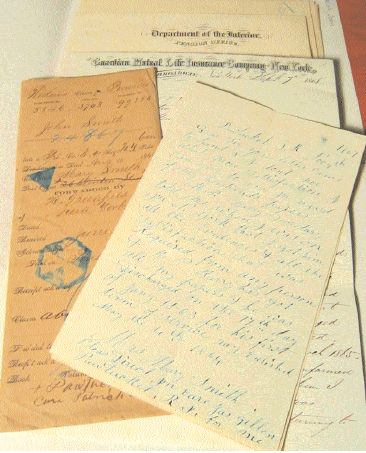
from herself, her huband's commanding officer, and various
officials.
Similar to pension files at the National Archives (NARA), the claim files include their original identifying jacket, and may contain any or all of the following: letters from servicemen, their family members, and military officers documenting service and health conditions; affidavits and other documents proving marriages, births, or deaths; and correspondence between the USSC and federal offices, and other parties. Multiple claim applications may have been filed for the same individual depending on the type of claim.
Understanding USSC record keeping practice is the key to full access to information. Keyword searches using Google or the NYPL’s archival portal will not be adequate to mine the genealogical gold in these records. Claim work was managed using registers — the nineteenth century equivalent of databases and spreadsheets — to track case work and correspondence.
Nevertheless, the claim files are an excellent starting point for soldier/sailor research. Only names are listed in the ANCA collection guide; however, reference staff and onsite researchers can inspect the actual file jackets for the serviceman’s military unit to ensure a match. Claim jackets for the PWCA (New York) may be found in their own files and sometimes those of the Central Office (ANCA). But not all claim cases warranted a file jacket to enclose paperwork, and in those instances, registers may carry the sole documentation for an individual.
Filing Systems
Claim applications were numbered and listed in registers. Those registers recorded names, addresses, status notations, and outcome of the claim. Outgoing correspondence was copied into letterpress copy books. Incoming correspondence and other documents could be filed in a jacket, forwarded to the U.S. government in support of claims, or kept in a larger filing alphabetical or numerical filing sequence.
Claim information and documentation was also organized by type of claim, registers for invalid and widows’ pensions being an example. Collection guides explain the type of record, the type of information found within, and the arrangement of the information.
File jackets, similar to those found in NARA, identify:
- the name and military unit of the soldier or sailor upon whose service the claim is based
- the claimant
- the agent handling the claim (the Central Office unless a local agent is identified)
- U.S. government and USSC filing numbers
- Related volume/page references and status notations
The file jackets can provide clues to other records, some originating in USSC agencies in the claimant’s home town. The USSC’s local agents kept their own set of claim ledgers, and their correspondence with the Central Office sheds further light on the needs of veterans and their families in local communities. Many of these agent records are found in the Army and Navy Claim Agency Archives.
Some correspondence was maintained outside the file jackets. When looking at any materials listed in alphabetical order, researchers will need to keep in mind that USSC staff indexed materials usually by the first letter of the surname or locality only. Thus, large alphabetical runs require extensive review. For records kept in chronological order, alphabetical indexes are sometimes available.
PWCPA (Philadelphia) used a slightly different system to file claim paperwork as explained in the guide. Their records may also be of use in identifying servicemen living in Philadelphia having New York or other origins.
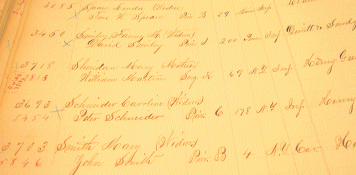
Pension register 3, p. 153, as cited on Smith
file jacket. Office numbers 3703 and 5846
confirm the reference.
In addition to assisting with claim prosecution, PWCA (New York) also ran an employment bureau for discharged and disabled soldiers and sailors. Those records are also found in the Army and Navy Claim Agency Archives and include registers listing those seeking employment and registers of employers with job openings. Records for a similar employment bureau in Philadelphia are found in the records of the USSC’s Philadelphia Agency (see Pennsylvania Archives, MssCol 18781). In both cases, applications for employment have name indexes.
The Hospital Directory and Other Special Relief Records
Through its special relief services, the USSC supported servicemen who, for various reasons, were separated from their units and required immediate assistance with food, clothing, shelter, or medical care. Separation was usually due to illness, furlough, or discharge. The USSC established soldiers’ homes (lodges providing temporary shelter and assistance) and other services at major transportation points, and in some cases sheltered female family members in search of a hospitalized soldier. These services are explained generally in the Special Relief Department records of the USSC Washington D.C. Archives (MssCol 22261).
Special relief records are found in the records of most war zone USSC Departments and in the Army of the Potomac Archives (MssCol 18782), as well as in some branch and agency records. Examples of the latter include the USSC Pennsylvania Archives (MssCol 18781) and the Executive Committee of Boston Associates (MssCol 18592). In the Western Department (MssCol 18779), the lodge records of Jeffersonville, Indiana, and Nashville, Tennessee list servicemen who received shelter; similar volumes are found in other departments. Although not indexed by name, with an established chronological and geographical connection and intensive searching, such records may yield results.
Hospital Directories
The USSC established the Hospital Directory in 1862. Its purpose was to collect and record information on the location and condition of sick and wounded soldiers in U.S. Army general hospitals at the home front and in war zones, and to provide that information to the public. The activities of its four offices are documented in the Hospital Directory Archives (MssCol 19877). The records contain:
- registers of military hospital patients (directories)
- files on individual soldiers containing letters from soldiers’ relatives, friends, regimental officers and surgeons, and Hospital Directory staff
- lists of deaths, burials, and prisoners of war
- administrative correspondence and record books
In the case of the USSC’s Hospital Directory Archives records, entries in directory registers are typically arranged by military unit and can be used to locate servicemen in specific hospitals. The military hierarchy in such USSC arrangements usually begins with state volunteer units, arranged alphabetically by state and military unit within, continuing with U.S. regiments and U.S. Colored Troops, U.S. Navy, and miscellaneous personnel. Information was entered chronologically and the volumes filled up. Therefore, matching a hospital date with the volume date span is critical as multiple registers may contain men of a particular state infantry regiment or other unit.
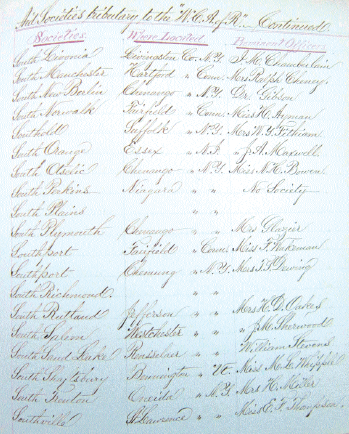
Prior to the 2010–2013 processing project, some Hospital Directory records were processed under a Save America’s Treasures grant. The NYPL’s USSC Civil War Soldiers Database was created to provide access by name and unit to “letter of inquiry” files in the Washington Hospital Directory. Such files may contain letters from soldiers’ families inquiring as to their whereabouts, and USSC correspondence attempting to locate them. A small number of naval personnel and others are included.
Hospital Directory records have now been fully arranged and incorporate previously unsorted materials. Box numbers appearing in the database have been renumbered, and a box “cross-walk” is available. Thus, researchers should note that the database is by no means a comprehensive listing of letter of inquiry materials, especially where the Directory’s Philadelphia office is concerned. Directory office registers for inquiries should also be consulted. In addition, as a result of the project, functional access has now been restored to well over 100 original “directories” used by staff to locate soldiers at hospitals. As in the Claim Agency records, register volumes often provide information not found in inquiry files. Other record groups may also contain records related to Hospital Directory services.
Other Activities
USSC records document interactions with thousands of servicemen, as well as some civilians, refugees, freedmen, and even Confederates in the course of its relief and sanitary work. The USSC’s Statistical Bureau conducted camp inspections and collected data on a variety of subjects used to improve the health and welfare of the soldiers (Statistical Bureau Archives, MssCol 18780). The Bureau’s records contain camp inspection reports identified by unit, and data (usually physical in nature) on individual soldiers. USSC collection guides introduce researchers to the variety of work accomplished in a particular location or organization, and the type and arrangement of information in those records. However, since many records are not indexed at the item level or arranged by name, intensive research is required.
Local History Resources
The collection also documents contributions to the war effort made by citizens in local communities that might otherwise remain unknown. Although the USSC used its organizational terms flexibly, a supporting “branch” organization in a large northern city usually consisted of an agency, run and staffed by men, and a women’s auxiliary association. The scope of their work and how they managed it is illustrated in the records of the USSC’s northeastern branches in New York City, Philadelphia, and Boston. [See New York, N.Y. Archives, MssCol 22263 and Woman’s Central Association of Relief (WCAR), MssCol 22266; Pennsylvania Archives, MssCol 18781 for the Philadelphia Agency and Women’s Pennsylvania Branch; and for Boston, the Executive Committee of Boston Associates Archives, MssCol 18592, and New England Women’s Auxiliary Association Archives (NEWAA), MssCol 18579.]
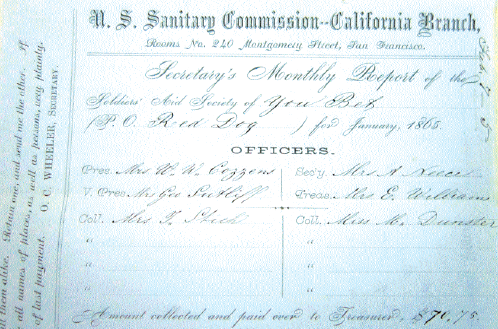
Women's Auxiliaries
Women, men, and even children supported the war effort through the donation of supplies (such as foodstuffs, hospital garments and linens, mittens, and socks) and money. Money was needed to cover operating expenses and to purchase items which could not be made at home.
Women’s auxiliaries collected supplies donated by Union supporters in their geographical area, working with aid societies and individuals. The auxiliaries sorted and reboxed donations by type, and shipped them to USSC depots, agencies in the field, or directly to hospitals and military units, depending on instructions received from USSC executive offices or agencies. These supplies supplemented governmental issue for camps, hospitals, and armies in the field in time of need. Auxiliaries also promoted the work of the USSC through correspondence, council meetings, lectures, and the distribution of USSC publications. It should be noted, however, that contributions of all kinds were also sent directly to agencies as well as to auxiliary associations.
Organization of Records
Women’s auxiliary records in the collection are organized by their committee-based working structure and/or by a geographical arrangement. By 1864, NEWAA, WCAR, and the Women’s Pennsylvania Branch established a county-based associate manager system to streamline their work processes. They used a geographical structure (state, county, locale) to organize information, and kept various indices to identify their main contacts in particular places, both for correspondence and supply purposes. Collection guides identify the variety of records kept and point the researcher to any index tools found within, or in other record groups.
The record of a community’s contributions will be found in both correspondence and supply records, and may extend outside a branch’s records to other parts of the collection. Correspondence, essentially narrative reports on local activities, often provides rich information beyond the scope of supplies contributed. Letters and reports open a window into the personal lives of the writers, tensions in village and town life, and the nature of Union support in an area, which was not always strong or universal.
An auxiliary’s regional networks varied over time and are best explored using the collection guides and the USSC’s printed publications. The records of New York City’s Woman’s Central Association of Relief, for example, document their coordination of supply work in New York State, parts of Connecticut and New Jersey, and elsewhere.
Records in Other Institutions
While the NYPL’s collection contains the records of the main eastern branches as well as its California and English Branches, there are other branches whose records are not extant in the collection. Not all records were kept or submitted to the USSC’s Historical Bureau after the war. Some branches decided to retain their records in local repositories rather than send them to the USSC, while other records were kept in private hands. Contemporary publications and newspaper accounts help shed light on the range of organizations that existed during the war.
A search of WorldCat’s ArchiveGrid (archivegrid.org) can help identify related USSC-related records held in other institutions. The same applies to independent organizations, not identified as branches, which may have worked with or supported the USSC.
While USSC urban fairs are discussed in some records, such fairs were often run by separate committees who maintained their own records. New York City’s 1864 Metropolitan Fair, for example, is not well-represented in this collection, but materials held elsewhere can be located using ArchiveGrid.
Other Aid Society Records
A broader geographical diversity is found in the local aid society records collected by the USSC’s Historical Bureau after the war. These records may include a financial report, a narrative of their activities, and, occasionally, original correspondence and other records, such as minutes, dating from the war. They are arranged alphabetically by state and then community, and are found in the New York, N.Y. Archives, Series IV.C., Historical Bureau records, Archive Department, under “Aid societies” (MssCol 22263). In addition, the Historical Bureau created a register of tributary aid societies and their primary officers, arranged by branch and then usually by town (volume 20). While helpful, this is not necessarily a comprehensive listing, and should be supplemented by Branch records and USSC publications (see below) when available. Using the records in combination will always generate the best results.
When looking for documentation on a particular village or town, it is helpful to look at contemporary maps. Some small communities worked together, or associated themselves with nearby larger communities. Transportation routes by road, rail, and water also give clues for such possible connections.
The records of the USSC’s Western Department (MssCol 18779), based in Louisville and supporting Union military operations in the Mississippi Valley area, contain administrative, supply and special relief records for various locations. There are no women’s auxiliary records at the branch level for this area in the collection, although its correspondence does document work with individual workers, aid societies, and branches. Fortunately, the Aid society reports found in the New York, N.Y. Archives Historical Bureau records, mentioned above, help address the gap in branch coverage for that area.
USSC local claim agency records in the Army and Navy Claim Agency Archives also provide insight into the cost of war faced by particular communities, as do the larger holdings for the Protective War Claim agencies in New York City and Philadelphia found within that record group.
Mission and Its Relation to Records.
Researchers will need to keep in mind that the type of documentation in the collection (as well as record keeping practices) often varies by location and mission. The primary purpose of the California Branch (MssCol 18580) was to raise money to support the USSC and the Union cause. Its agents travelled throughout California and to neighboring territories to coordinate supporting societies and raise subscriptions. Agent reports are one example of USSC assessments of the pulse of a community’s support of the Union. Similarly, branches such as WCAR and NEWAA engaged lecturers to promote USSC work. Their reports, encountered in correspondence and other records, provide similar evidence. Both identify persons or groups likely to assist the USSC, and the strength of Union support in the area. The USSC also had branches outside of the United States; the records of the English Branch are extant in the collection (MssCol 18818).
USSC Publications
USSC printed publications (circulars, pamphlets, periodicals and books) are another valuable resource. These include, for example, the USSC’s wartime periodicals, the Bulletin and the Sanitary Reporter; the History of the United States Sanitary Commission by Charles J. Stillé (1866); annual and quarterly reports of branches or aid societies; and the Documents of the U.S. Sanitary Commission. Many of these can be found online in HathiTrust, Internet Archive, or Google Books. These and other war-related publications kept by the USSC’s archives are contained in the Condensed Historical Matter record group (MssCol 18819). Due to the fragile condition of some materials, surrogate copies must be used when available. The collection guide can act as a handy (though not complete) bibliography of contemporary publications.
USSC Employees
Although parts of the USSC organization, notably its auxiliary associations, worked on a volunteer basis, certain jobs required greater contractual accountability, particularly in war zones. Several hundred salaried workers at many levels of duty, including female employees, are listed by name in USSC staff rosters found in its accounting and other records. See particularly the Accounts and Vouchers Archive (MssCol 18820).
Research Tips
When looking for records concerning individual servicemen, it is recommended that researchers first explore service and pension records at the National Archives, and in state and other repositories. This gives a better sense of an individual’s service over time and place. Once a brief outline of the soldier’s service and military unit(s) and his civilian residences before and after the war is known, it will be easier to look through his service records for points where he or his family might have come into contact with USSC services.
The important thing to keep in mind is that the USSC was not a static organization. The USSC’s executive structure and subordinate organizations grew with the expansion of the war. Management systems were adjusted. “Relief” service goals changed to meet the needs of soldiers and their families as large numbers of discharged and disabled servicemen returned home. Departments and agencies working in the field grew, while some smaller stations closed down and moved as the armies themselves moved on campaign. USSC relief agents accompanied armies on the march (see for example the Army of the Potomac Archives, MssCol 18782). When looking for mention of family members, be they soldier, sailor, or civilian, overlay the “who, what, when, where” of their lives onto the USSC’s own service “coordinates.”
USSC Records Groups; Master Collection Guide (MssCol 3101)
| Group | Title | Group | Title |
|---|---|---|---|
| I | Accounts and Vouchers Archive (MssCol 18820) | XI | Executive Committee of Boston Associate Archives (MssCol 18592) |
| II | American Association for the Relief of Misery of Battle Fields Archives (MssCol 22290) | XII | Hospital Directory Archives (MssCol 19877) |
| III | Army and Navy Claim Agency Archives (MssCol 18809) | XIII | Maryland Archives (MssCol 18817) |
| IV | Army of the Potomac Archives (MssCol 18782) | XIV | New England Women’s Auxiliary Association Archives (MssCol 18579) |
| V | California Branch Archives (MssCol 18580) | XV | New York, N.Y. Archives (MssCol 22263) |
| VI | Condensed Historical Matter (MssCol 18819) | XVI | Pennsylvania Archives (MssCol 18781) |
| VII | Department of North Carolina Archives (MssCol 18581) | XVII | Statistical Bureau Archives (MssCol 18780) |
| VIII | Department of the Gulf Archives (MssCol 18590) | XVIII | Washington D.C. Archives (MssCol 22261) |
| IX | Department of the Shenandoah Archives (MssCol 18591) | XIX | Western Department Archives (MssCol 18779) |
| X | English Branch Archives (MssCol 18818) | XX | Woman’s Central Association of Relief (MssCol 22266) |
Contacting the NYPL's Manuscripts and Archives Division
The Manuscript and Archives Division’s public service staff will be happy to help with any questions researchers may have concerning the United States Sanitary Commission records and their relevancy to genealogical research. Start by reviewing the “master collection guide” for the United States Sanitary Commission records (MssCol 3101) and other pertinent collection guides, available at archives.nypl.org. Then, click on the “Contact the Division” tab on either the master collection guide for a general query regarding multiple record groups, or use the same tab on a specific record group of interest. Complete the form to identify yourself as a researcher, and submit your question. The Library will respond as soon as possible.
Due to the fragile nature of some materials, and the complexity of the USSC’s record keeping system, we strongly recommend onsite research to get the best results. We can advise on research strategies and do limited checking for reference purposes, but researchers will need to do the in-depth searching needed to pull together all possible information on one individual, one community, or all individuals belonging to one particular military unit. Any duplication requests will be reviewed by staff.
Archives staff are happy to work with professional researchers and others wishing to consult materials on a researcher’s behalf.
by Susan P. Waide
Originally published in the New York Researcher, Winter 2014, vol. 25, no. 4.
© 2017 New York Genealogical and Biographical Society
All rights reserved.
Susan P. Waide is an archivist at the Manuscripts and Archives Division of The New York Public Library.